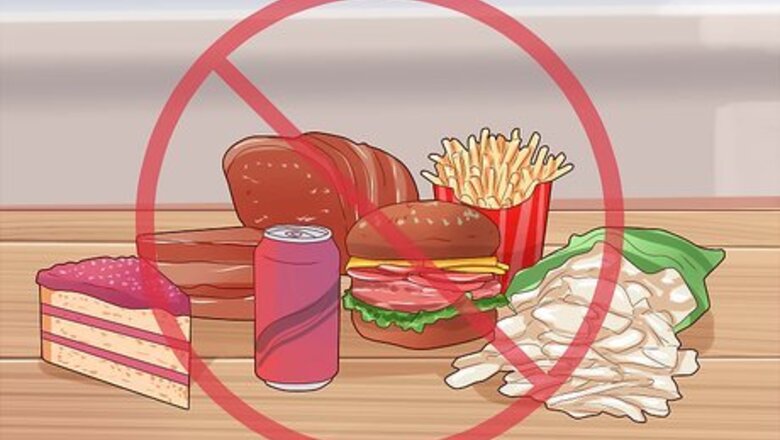
views
X
Research source
It’s wise to focus on long-term treatment of your acid reflux in order to allow the esophagus time to heal to prevent long-term damage. Experts note that through lifestyle changes and medication, you can heal your esophagus and keep your digestive system in working order.[2]
X
Research source
Changing Your Lifestyle
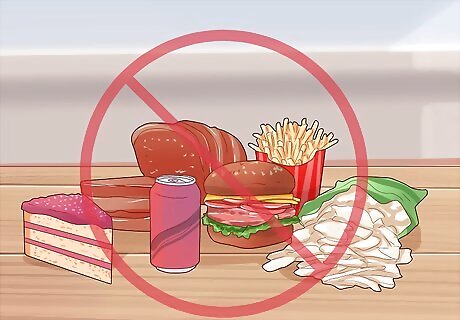
Eat the right food at the right time. Fried foods, fatty foods, alcoholic beverages, tomatoes, and caffeinated drinks such as coffee, tea, and soda can increase the acid levels within the stomach. Try to take away these foods and liquids from your diet so that your esophagus can heal. There are other dietary restrictions as well. Dairy products, such as whole milk, cheese, butter, and sour cream, are also to be avoided. Also avoid food containing peppermint or spearmint. There are also fruits you should avoid as well, such as oranges, lemons, lime, grapefruit, and pineapples. If you do find yourself consuming these foods, drink plenty of water and eat approved foods to dilute their acidic powers.
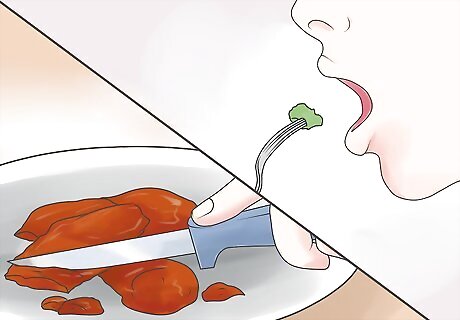
Eat a small amount of food frequently. Create five to seven divided meals a day and avoid eating two to three hours before bedtime. The esophageal sphincter of the stomach relaxes when the stomach gets too full, bringing the hydrochloric acid up into the esophageal walls. In other words, if you eat too much, your esophagus will let you know. It's best to avoid it by eating smaller meals more often. Most of us frequently have this issue out at restaurants. At home it isn't so bad, but at restaurants it's just so tempting to finish what's in front of you, which is often too much. To avoid the impending disaster, box up half of your meal at the very beginning. You can take it home to eat later later.
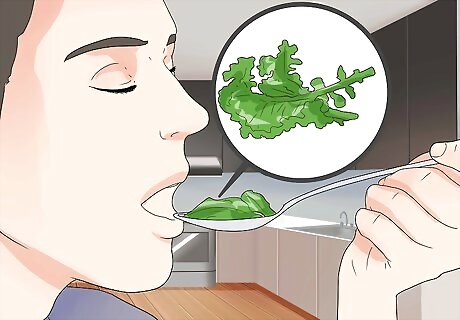
Incorporate good food in your daily diet plan. There are a few foods you should be eating every day to combat acid reflux. These include: Oatmeal. Oatmeal makes you feel full without causing reflux. It also absorbs the acid in fruits if you add a small amount. This will considerably aid in lowering the acidity in the stomach. Ginger. Ginger contains anti-inflammatory ingredients to help treat various gastrointestinal problems. Peel or slice ginger roots and add it to your favorite recipes. Green vegetables. Green leafy vegetable contain low calories and zero saturated fat. It’s the most recommended diet for patients suffering from acid reflux. Just be sure to stay away from using tomatoes, onions, cheese, and high-fat salad dressing. Try asparagus, cauliflower, parsley, and other green vegetables. White meat. Red meats such as steak and beef are hard to digest, so go for chicken and turkey meats instead. Chicken makes good soup, too. The chicken skin contains a high amount of fat, though, so remove it before cooking. Poultry meats can be boiled or grilled; avoid eating them fried. Seafood. Just like poultry, fish, shrimp, and other seafood also help avoid acid reflux. Just don’t fry them. Seafood is easily digested and is very low in fat and therefore helps prevent reflux and avoid heartburn.
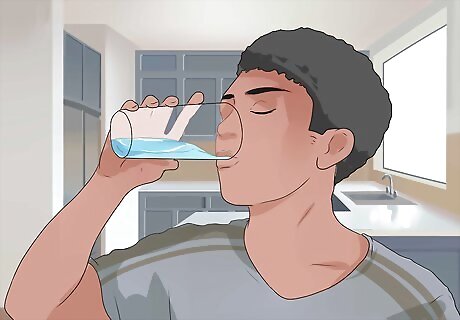
Drink plenty of water. You should be drinking eight to 12 glasses of water every day to prevent dehydration. It will help dilute the acid contents found in your stomach and gut, making it less acidic. And your hair, skin, nails, and organs will benefit, too.
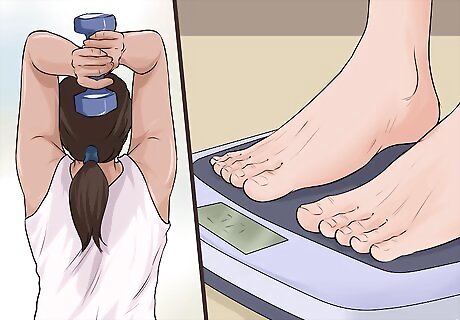
Stay fit and healthy. Obesity and excess weight are among the major risk factors of having acid reflux. Start an exercise program that focuses on simple exercises that can help burn calories and start eating healthier. A thirty minute walk in the park can burn up to 100 calories. Dieting doesn't mean you have to starve yourself. Try to exercise more, eat smaller amounts per day, and eat more low caloric food that are better for you. You don't have to go hungry. Having an active lifestyle can fight off heart disease, diabetes, and a number of other health issues as well. Focus on leisure activities like dancing, horseback rides, or golf. It’s fun to burn calories while doing what you love. Then, slowly increase your physical activity as you get stronger. Determine your body mass index and start losing weight. The normal body mass index (BMI) range from 18.5 to 24.9. This will help you determine if your weight is currently on the normal range. You can manually calculate your BMI by dividing your body weight in kilograms by your height in meters squared, or you could use an online guide or calculator. Count your daily required calories and track the food that you eat. A total of 3500 calories is equivalent to 1 pound. So if you plan to lose 1 pound per week, you need to cut 500 calories from your daily required caloric intake.
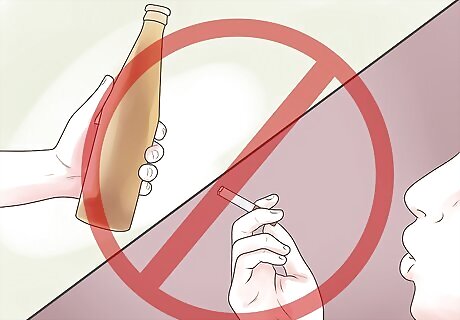
Quit smoking and avoid alcohol. Smoking irritates the esophageal lining which causes more inflammation and pain. If you can’t stop smoking you should gradually decrease the amount you smoke per day. If your overall health wasn't reason enough, do it to make the everyday acid-reflux free. Drinking beer and other carbonated beverages can also cause harm to the linings of the esophagus and stomach. It is best to have total abstinence from smoking and drinking.

Elevate the head of your bed during sleep. You should elevate the head of your bed using pillows by about six to eight inches (15 to 20 cm). Improvement of symptoms can be resolved when the upper body is elevated. It will prevent reflux of acid or any gastric contents while sleeping. While you're at it, get enough sleep, too. Having enough rest and enough hours of sleep will allow your body to relax, repair, and build up damaged tissues and muscles in the body. Muscle and tissue repairs happen when the body is at rest or in a sleeping state. Enough sleep is at least seven to eight hours per day.
Using Home Remedies

Try apple cider vinegar. Although is may seem counter-intuitive considering that acidic foods are definitely not recommended for acid reflux, the acetic acid which is the main ingredient of apple cider vinegar is a weaker acid compared to the hydrochloric acid being produced in the stomach. Consuming this kind of acid tends to balance the acid production in your stomach and allows it to reach neutral acid levels. Apple cider vinegar is available in many grocery stores and supermarkets. Mix one to two tablespoons with eight ounces of water before meals. You may also add a teaspoon of honey to improve its taste. Apple cider vinegar makes tasty vegetable salad dressing, too.

Drink water mixed with baking soda. You can mix a ½ teaspoon of baking soda in a glass of water as a natural antacid. Knowing that baking soda is a base, it will help to neutralize the acidity in the stomach. Take precaution when using baking soda, however, because this is high in sodium. Too much sodium is definitely not a good thing, especially for acid reflux.
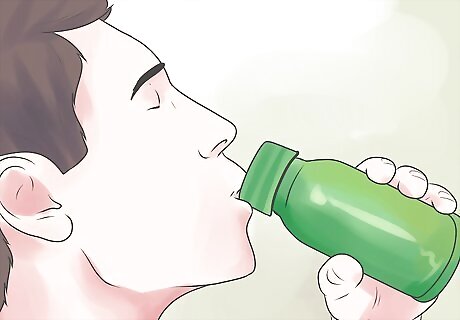
Try aloe vera juice. Aloe vera gel and leaves can be made into juice. Aloe vera contains glycoprotein, which is an essential healing property to reduce esophageal irritation and polysaccharides to promote tissue repair. Aloe vera is one of the medicinal plants approved by the Food and Drug Administration. Drink two to three ounces of aloe vera juice in an empty stomach or 20 minutes before a meal to treat acid reflux. Be careful not to use this remedy too much because it's a known laxative.
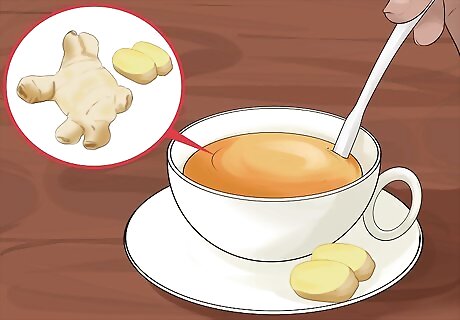
Drink ginger tea with honey. Ginger contains natural anti-inflammatory ingredients while honey coats the esophageal walls, preventing cell inflammation. Add two to four grams of ginger powder in hot water to make tea. You can also cut a regular size piece of ginger root into bits and bring it to boil. Add a teaspoon or more of honey to taste. Make sure it's not too hot. You don't want to burn your esophagus.
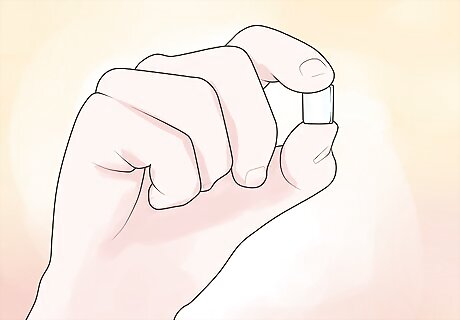
Chew sugar free gum. For 30 minutes after a meal, chew a piece of sugarless gum. This will increase saliva production and will help neutralize the acid in the stomach. Also, the acid in the gut will be excreted due to a large amount of saliva that was ingested.
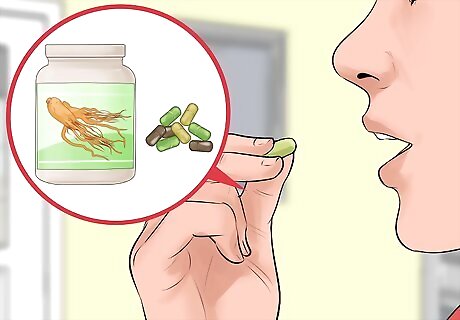
Try licorice. For centuries, the roots of the licorice plant have been used for cuisines and for medicine. You can also try deglycyrrhizinated licorice, which is a tablet that you can chew about 15 minutes before you eat to protect the lining of your stomach and esophagus and prevent future acid reflux. Licorice increases the number of mucous secreting cells in the stomach and enhances the life of intestinal cells as well. Likewise, it improves the microcirculation in the gastrointestinal tract.
Using Medical Treatment
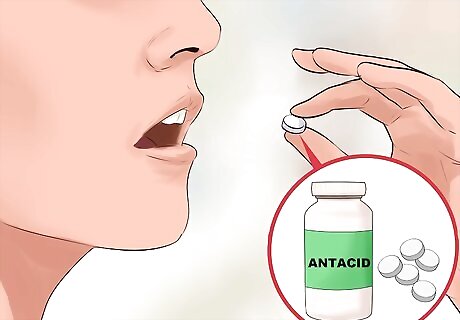
Start taking antacids. Antacids neutralize acids in the stomach. Moreover, they help build mucous secretions and bicarbonate, which, in turn, increases your stomach's pH levels, which makes it less acidic. Tums and Gaviscon are well-known antacid brands. These are more of a crutch than anything and won't fight long-term acid reflux. While they're great in the here and now, you should seek other methods of treatment so you don't have to rely on antacids for long periods of time.
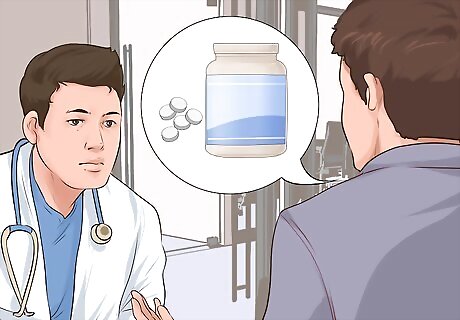
Talk to your doctor about H2 receptor antagonists. H2 antagonists prevent the histamine at H2 receptors, thereby reducing the gastric acid secretion within the stomach. They prevent new stomach acid from forming, so the stomach and esophagus can heal and you can be free of acid reflux symptoms. Zantac, Tagamet, and Pepcid are few examples of H2 receptor antagonists. Famotidine (Pepcid) is available in 20mg and 40mg. You can take 20mg twice daily for six weeks. Nizatidine (Axid) is available in 150mg and 300mg. You can take 150mg twice daily. Ranitidine (Zantac) is available in 150mg and 300mg. You can take 150mg twice daily.

Consider proton pump inhibitors. Proton-pump inhibitors (PPIs) are medications that decrease the acid production by blocking the enzyme in the stomach walls that produces acid. These medications include omeprazole, lansoprazole, and pantoprazole. Lansoprazole (Prevacid) is an over-the-counter PPI, available in 15 and 30mg. You can take 15mg once daily for eight weeks. Esomeprazole (Nexium) and pantoprazole (Protonix) require a prescription. Your doctor will determine the course of these drugs. Omeprazole (Prilosec) is an OTC PPI, available in 10mg, 20mg, and 40mg. You can take 20mg once daily for four weeks.

Ask you doctor about prokinetics. You can prokinetic medication as a way to advance gastric emptying. All require a prescription and should only be taken if your doctor thinks it's appropriate for your case. The medications under this classification include: Bethanechol (Urecholine) Domperidone (Motilium) Metoclopramide (Reglan)

Consider surgical treatment. Surgical intervention comes in when medications and medical management can no longer treat or heal acid reflux. It also is suggested often for patients who suffer from severe acid reflux. It is the only method that can cure the cause of acid reflux instead of just treating the symptoms. Often, even if medications and lifestyle changes help, acid reflux returns once these methods are stopped. This causes many to consider surgery. The surgery for acid reflux is a minimally invasive surgical procedure called Nissen Fundoplication. This procedure involves wrapping a portion of the gastric fundus, or stomach, around the esophageal sphincter. There is a new surgical procedure that doesn't use incisions and instead goes through the mouth. This greatly reduces the recovery time from the surgery and has the same outcome.
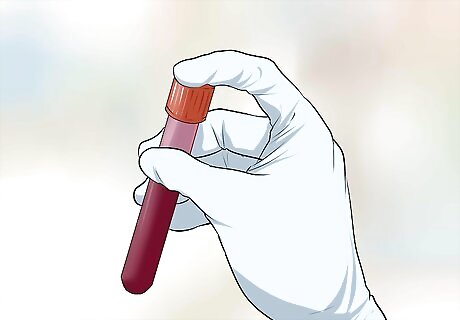
Consider more intense treatment. If your acid reflux has caused extensive damage to your esophagus, such as erosive esophagitis, Barrett’s Esophagus, or esophageal cancer, your doctor will recommend a series of treatments that depend on the severity of your condition. In these cases, an endoscopy is often done to assess the damage to the esophagus. Depending on how bad your case is, the doctor may consider keeping an eye on the damage, performing an biopsy to test for cancerous cells, or giving you medication. In cases where cancer or other advanced conditions are found, other surgical procedures, such as radiofrequency ablation, may be performed.
Understanding Acid Reflux
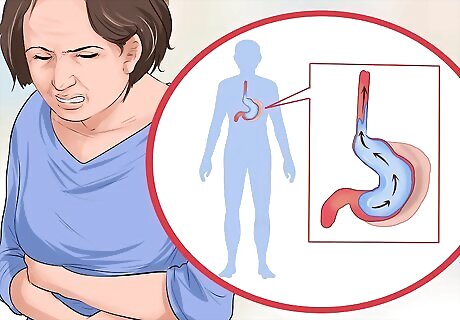
Understand acid reflux. Gastroesophageal Reflux Disorder, also known as GERD or acid reflux, is a disorder is which contents from your stomach and intestines enter your esophagus. The acid from the stomach migrates upwards past your lower esophagus, causing a burning pain and, at times, actual erosion of the tissue of the esophagus. Approximately 25 to 35% of Americans are affected acid reflux. It is uncomfortable and quite painful in some cases. The discomfort can be assessed on a spectrum from just mild burning to a severe burning chest pain, mimicking a heart attack. The pain of acid reflux is brought on by the gastric fluid, which has a very low acidic pH. It migrates up the esophagus and finds its way into an environment where it doesn’t belong and is not intended to be, such as your esophagus.

Recognize the causes. The migration of gastric fluid that causes acid reflux can be caused by a loose lower esophageal sphincter (LES). It can also be due to gravity, which can take effect if you lie down right after a meal. Acid reflux can also be caused by overeating and applying too much pressure to the LES, forcing the stomach contents back past the sphincter. Other situations that may cause acid reflux are smoking, obesity, high intake of sodium, low intake of dietary fiber, limited physical exercise, and taking certain medications.

Be aware of underlying conditions. There are multiple underlying conditions that can cause or be caused by acid reflux. Other conditions that can lead to acid reflux are pregnancy and a hiatal hernia, which is where a hole in the diaphragm allows the upper portion of the stomach to enter the chest cavity. Acid reflux can cause other conditions, such as a condition called Barrett’s Esophagus. Ask your doctor if you think your acid reflux has an underlying conditional cause or if you think it is causing more serious problems.




















Comments
0 comment